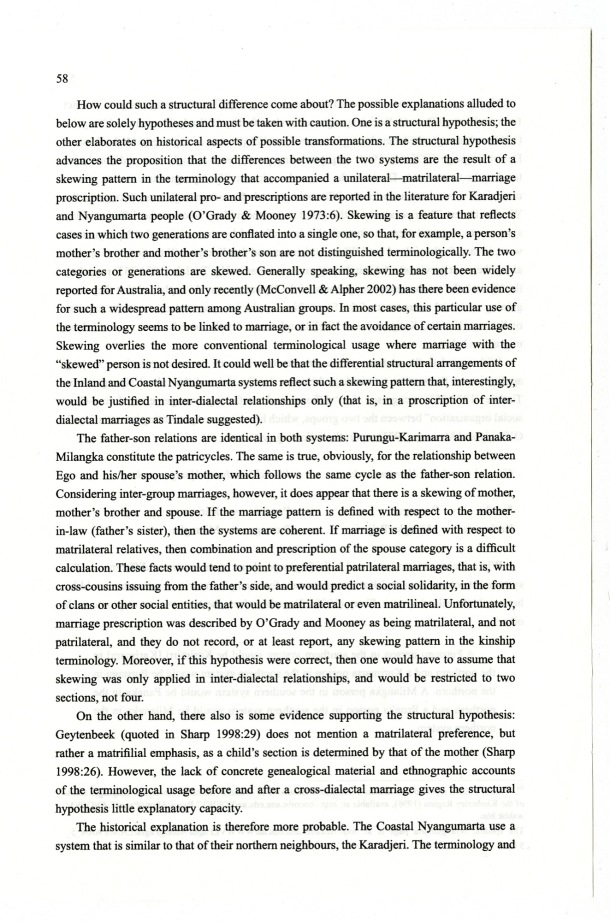|
| 
[Note: this transcription was produced by an automatic OCR engine]
58
How could such a structural difference come about? The possible explanations alluded to
below are solely hypotheses and must be taken with caution. One is a structural hypothesis; the
other elaborates on historical aspects of possible transformations. The structural hypothesis
advances the proposition that the differences between the two systems are the result of a
skewing pattern in the terminology that accompanied a unilatera.l—matrilateral—marriage
prescription. Such unilateral pro— and prescriptions are reported in the literature for Karadjeri
and Nyangumarta people O’Grady Mooney 197326. Skewing is a feature that reflects
cases in which two generations are conflated into a single one, so that, for example, a person’s
mother’s brother and mother’s brother’s son are not distinguished terminologically. The two
categories or generations are skewed. Generally speaking, skewing has not been widely
reported for Australia, and only recently McConvell Alpher 2002 has there been evidence
for such a widespread pattern among Australian groups. In most cases, this particular use of
the terminology seems to be linked to marriage, or in fact the avoidance of certain marriages.
Skewing overlies the more conventional terminological usage where marriage with the
“skewed” person is not desired. It could well be that the differential structural arrangements of
the Inland and Coastal Nyangurnarta systems reflect such a skewing pattern that, interestingly,
would be justified in inteiudialectal relationships only that is, in a proscription of inter-
dialectal marriages as Tindale suggested.
The father-son relations are identical in both systems: Purungu-Karimarra and Panaka-
Milangka constitute the patricycles. The same is true, obviously, for the relationship between
Ego and his/l1er spouse’s mother, which follows the same cycle as the father-son relation.
Considering inter-group marriages, however, it does appear that there is a skewing of mother,
mother’s brother and spouse. If the marriage pattern is defined with respect to the mother-
in-law father’s sister, then the systems are coherent. If marriage is defined with respect to
matrilateral relatives, then combination and prescription of the spouse category is a difficult
calculation. These facm would tend to point to preferential patrilateral marriages, that is, with
cross-cousins issuing from the father’s side, and would predict a social solidarity, in the form
of clans or other social entities, that would be matrilateral or even matrilineal. Unfortunately,
marriage prescription was described by O’Grady and Mooney as being matrilateral, and not
patrilateral, and they do not record, or at least report, any skewing pattern in the kinship
terminology. Moreover, if this hypothesis were correct, then one would have to assume that
skewing was only applied in inter-dialectal relationships, and would be restricted to two
sections, not four.
On the other hand, there also is some evidence supporting the structural hypothesis:
Geytenbeek quoted in Sharp 1998229 does not mention a matrilateral preference, but
rather a matrifilial emphasis, as a child's section is determined by that of the mother Sharp
1998226. However, the lack of concrete genealogical material and ethnographic accounts
of the terminological usage before and after a cross—dialectal marriage gives the structural
hypothesis little explanatory capacity.
The historical explanation is therefore more probable. The Coastal Nyangumarta use a
system that is similar to that of their northern neighbours, the Karadjeri. The terminology and
|